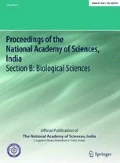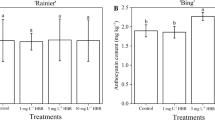Abstract
Changes during development of Santalum album L. berries were studied with respect to contents of pigment, carbohydrates, proteins, phenols, organic acids, colour and biomass. Cyanidin-3-glucoside (anthocyanin pigment) content increased rapidly from early (green) through intermediate (pink) to matured stage (black). Carbohydrates and proteins contents also increased during berry development. Phenols contents got reduced on maturation of the berries while total organic acids contents increased. Colour parameters such as L, b and chroma values decreased, whereas a value increased from green to pink stage, then decreased on ripening of the berries. Although berry size increased but seed weight did not change indicating biomass increase. From the present study, it is concluded that only the black (or matured) berries of S. album may be harvested for maximum yield of anthocyanin pigment.


Similar content being viewed by others
References
Wealth of India (1972) Raw Materials, vol 9. NISCAIR, Council of Scientific and Industrial Research, New Delhi, pp 208–224
Sri Harsha PSC, Khan MI, Prabhakar P, Giridhar P (2013) Cyanidin-3-glucoside, nutritionally important constituents and in vitro antioxidant activities of Santalum album L. berries. Food Res Int 50:275–281
Cuénoud P, Savolainen V, Chatrou LW, Powell M, Grayer RJ, Chase MW (2002) Molecular phylogenetics of Caryophyllales based on nuclear 18S rDNA and plastid rbcL, atpB, and matK DNA sequences. Am J Bot 89:132–144
Clement JS, Mabry TJ (1996) Pigment evolution in the caryophyllales: a systematic overview. Bot Acta 109:360–367
Sharma G (2013) Role of phytochemicals and nucleic acids in solving taxonomic problems. Proc Natl Acad Sci India Sect B 83:141–145
Singh S, Singh DR, Banu S, Salim KM (2013) Determination of bioactives and antioxidant activity in Eryngium foetidum L.: a traditional culinary and medicinal herb. Proc Natl Acad Sci India Sect B 83:453–460
Usenik V, Štampar F, Veberic R (2009) Anthocyanins and fruit colour in plums (Prunus domestica L.) during ripening. Food Chem 114:529–534
Celik H, Ozgen M, Serce S, Kaya C (2008) Phytochemical accumulation and antioxidant capacity at four maturity stages of cranberry fruit. Sci Hort 117:345–348
Lee J, Durst RW, Wrolstad RE (2005) Determination of total monomeric anthocyanins pigment content of berry juices, beverages, natural colorants and wines by the pH differential method: collaborative study. J Assoc Anal Chem Int 88:1269–1278
Wilkinson M, Sweeny JG, Iacobucci GA (1977) High pressure liquid chromatography of anthocyanidins. J Chromatogr 132:349–351
Khan MI, Sri Harsha PSC, Giridhar P, Ravishankar GA (2011) Berberine and lycopene profiling during the ontogeny of Tinospora cordifolia (Willd.) Miers ex Hook. f & Thoms fruit. Curr Sci 100:1225–1231
Sadasivam S, Manickam A (2008) Biochemical methods, 3rd edn. New age International publishers, New Delhi
Marconi O, Floridi S, Montanari L (2007) Organic acids profile in tomato juice by HPLC with UV detection. J Food Qual 30:253–256
Koning RE (1994) Fruit ripening. Available at: Plant Physiology Information Website. http://plantphys.info/plants_human/fruitgrowripe.shtml. Accessed 16 Apr 2011
Tucker GA, Grierson D (1987) In: Stumpf PK, Conn EE (eds) The biochemistry of plants: a comprehensive treatise. Academic Press, San Diego, pp 265–318
Arena ME, Curvetto N (2008) Berberis buxifolia fruiting: kinetic growth behavior and evolution of chemical properties during the fruiting period and different growing seasons. Sci Hort 118:120–127
Nergiz C, Ergonul PG (2009) Organic acid content and composition of the olive fruits during ripening and its relationship with oil and sugar. Sci Hort 122:216–220
Serrano M, Guillen F, Martinez-Romero D, Castillo S, Valero D (2005) Chemical constituents and antioxidant activity of sweet cherry at different ripening stages. J Agric Food Chem 53:2741–2745
Glew RH, Ayaz FA, Sanz C, Vanderjagt DJ, Huang H-S, Chuang L-T, Strnad M (2003) Changes in sugars, organic acids and amino acids in medlar (Mespilus germanica L.) during fruit development and maturation. Food Chem 83:363–369
Ebrahimzadeh H, Motamed N, Rastgar-Jazii F, Montasser-Kouhsaiu S, Shokraii EH (2003) Oxidative enzyme activities and soluble protein content in leaves and fruits of olives during ripening. J Food Biochem 27:181–196
Ayan AK, Yanar O, Cirak C, Bilgener M (2007) Morphogenetic and diurnal variation of total phenols in some Hypericum species from Turkey during their phenological cycles. Bangladesh J Bot 36:39–46
Zheng J, Kallio H, Yang B (2009) Effects of latitude and weather conditions on sugars, fruit acids and ascorbic acid in currant (Ribes sp.) cultivars. J Sci Food Agric 89:2011–2023
Ozgen M, Smith JD, Palta JD (2002) Ripening stage has a dramatic influence on cranberry fruit postharvest shelf life: physiological and anatomical explanations. Postharvest Biol Technol 24:291–299
Gonçalves B, Silva AP, Moutinho-Pereira J, Bacelar E, Rosa E, Meyer AS (2007) Effect of ripeness and postharvest storage on the evolution of colour and anthocyanins in cherries (Prunus avium L.). Food Chem 103:976–984
Acknowledgments
Authors acknowledge Department of Biotechnology (Govt. of India), New Delhi for financial support to this project. Mohammad Imtiyaj Khan is grateful to CSIR, New Delhi for awarding Senior Research Fellowship.
Author information
Authors and Affiliations
Corresponding author
Rights and permissions
About this article
Cite this article
Khan, M.I., Giridhar, P. The Berries of Santalum album L. as a New Source of Cyanidin-3-Glucoside and Chemical Profiling during Different Stages of Berry Development. Proc. Natl. Acad. Sci., India, Sect. B Biol. Sci. 84, 689–694 (2014). https://doi.org/10.1007/s40011-014-0312-0
Received:
Revised:
Accepted:
Published:
Issue Date:
DOI: https://doi.org/10.1007/s40011-014-0312-0




